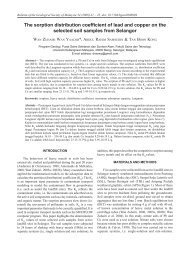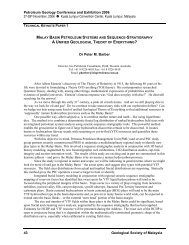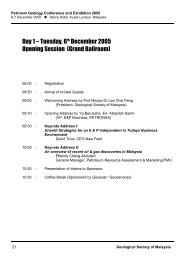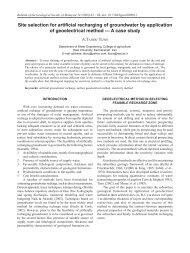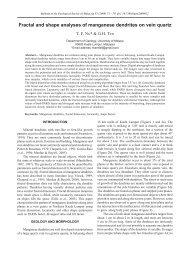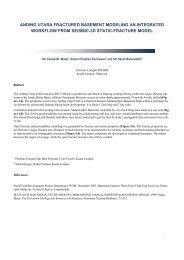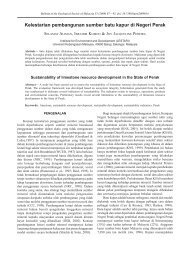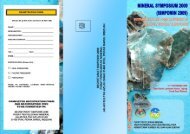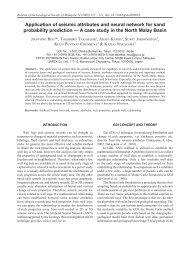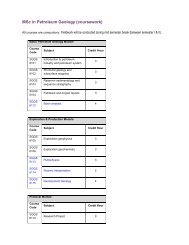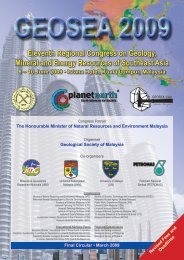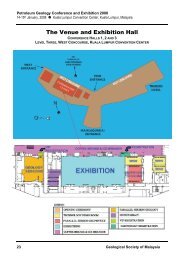The mineralogy of gold mineralization of the Ajmal Mine, Kechau Tui ...
The mineralogy of gold mineralization of the Ajmal Mine, Kechau Tui ...
The mineralogy of gold mineralization of the Ajmal Mine, Kechau Tui ...
Create successful ePaper yourself
Turn your PDF publications into a flip-book with our unique Google optimized e-Paper software.
Wa n Fu a d Wa n Ha s s a n<br />
bearing quartz veins are invaded by galena-bearing solutions<br />
which carry no <strong>gold</strong>. <strong>Mine</strong>ralogical differences reflect<br />
<strong>the</strong> differences <strong>of</strong> <strong>the</strong> source content, temperature and<br />
chemistry <strong>of</strong> <strong>the</strong> hydro<strong>the</strong>rmal solution. But as a class, <strong>the</strong><br />
<strong>gold</strong> <strong>mineralization</strong> in <strong>the</strong> <strong>Ajmal</strong> <strong>Mine</strong> is not different from<br />
those <strong>of</strong> Penjom, Lubuk Mandi and many o<strong>the</strong>r primary<br />
<strong>gold</strong> <strong>mineralization</strong>s in <strong>the</strong> Peninsula.<br />
Absence <strong>of</strong> well-define wall-rock alteration suggests<br />
a low temperature <strong>of</strong> deposition and <strong>the</strong> aqueous nature <strong>of</strong><br />
<strong>the</strong> mineralizing solution. At low temperature <strong>the</strong>re would<br />
be less interaction between <strong>the</strong> reactive calcareous rock<br />
and <strong>the</strong> aqueous solution and only a weak silicification<br />
was recognized.<br />
<strong>The</strong> olive-gray sulphide was correctly identified as<br />
tetrahedrite by Cheang (1988). <strong>The</strong> EPMA image <strong>of</strong> <strong>the</strong><br />
present analysis indicates Sb as <strong>the</strong> major component and<br />
only traces <strong>of</strong> As to justify it as tetrahedrite and <strong>the</strong> inclusion<br />
<strong>of</strong> its As end-member is unnecessary.<br />
<strong>The</strong>re is plenty <strong>of</strong> a carbonate mineral in <strong>the</strong><br />
hydro<strong>the</strong>rmal solution as evidenced by <strong>the</strong> presence <strong>of</strong><br />
carbonate toge<strong>the</strong>r with <strong>the</strong> white quartz in <strong>the</strong> <strong>gold</strong>bearing<br />
vein. This carbonate is identified as dolomite by<br />
XRD (Norhasfiza, 2003). Its role in <strong>mineralization</strong> was not<br />
fully emphasized until recently, e.g. by Lowenstern (2001)<br />
who suggested that <strong>the</strong> presence <strong>of</strong> CO 2<br />
aid <strong>the</strong> process <strong>of</strong><br />
metallogenesis including <strong>gold</strong>.<br />
Conclusion<br />
<strong>The</strong> <strong>gold</strong> <strong>mineralization</strong> in <strong>the</strong> <strong>Ajmal</strong> <strong>Mine</strong> is a variation<br />
<strong>of</strong> <strong>the</strong> primary <strong>gold</strong> <strong>mineralization</strong> style found in Peninsular<br />
Malaysia. Fine-grained native <strong>gold</strong> is found in clean quartz<br />
veins in association with tetrahedrite and some galena,<br />
chalcopyrite and sphalerite and petzite. <strong>The</strong> late phase <strong>of</strong><br />
<strong>mineralization</strong> carrying galena is poor in <strong>gold</strong>.<br />
Acknowledgment<br />
This work was carried out as a part <strong>of</strong> IRPA grant 02-<br />
02-02-0020. <strong>The</strong> writer wishes to thank Pn Mahani Samad<br />
for drafting <strong>the</strong> figures in this paper.<br />
References<br />
Cheang, K.K., 1988. Gold-bearing quartz veins from <strong>the</strong> <strong>Ajmal</strong> <strong>Mine</strong>,<br />
Kuala Lipis, Pahang, Malaysia. Warta Geologi, 14, 30.<br />
Gunn A.G., 1994. Final Report: Summary, Conclusions and<br />
Recommendations. Geological Survey <strong>of</strong> Malaysia, British<br />
Geological Survey Gold Sub-Programme. (unpublished)<br />
Heru Sigit Purwanto, 2002. Gold mineralisation and structural<br />
control in <strong>the</strong> Penjom area, Pahang and Lubuk Mandi area,<br />
Terengganu, Peninsular Malaysia. Unpublished Ph. D. <strong>The</strong>sis,<br />
Universiti Kebangsaan Malaysia (in Malay).<br />
Kee L. Y., 1990. Geology <strong>of</strong> Western Kuala Lipis, Pahang Darul<br />
Makmur. Unpublished B.Sc <strong>The</strong>sis, Universiti Kebangsaan<br />
Malaysia (in Malay).<br />
Lowenstren, J.B., 2001. Carbon dioxide in magmas and implications<br />
for hydro<strong>the</strong>rmal systems. <strong>Mine</strong>ralium Deposita, 36(6), 490-<br />
502.<br />
Norhasfiza binti Zainal, 2003. Gold mineralisation in <strong>Ajmal</strong> quarry,<br />
Kuala Lipis, Pahang. Unpublished B.Sc <strong>The</strong>sis, Universiti<br />
Kebangsaan Malaysia (in Malay).<br />
Richardson 1950. <strong>The</strong> geology and mineral resources <strong>of</strong> <strong>the</strong><br />
neighbourhood <strong>of</strong> Chegar Perah and Merapoh, Pahang.<br />
Geolological Survey Malaysia Memoir 4, 162 p.<br />
Rohana binti Deraman, 2003. Geology <strong>of</strong> <strong>Ajmal</strong> quarry, <strong>Kechau</strong><br />
<strong>Tui</strong>, Kuala Lipis, Pahang. Unpublished B.Sc. <strong>The</strong>sis, Universiti<br />
Kebangsaan Malaysia (in Malay).<br />
Yin, E.H. 1965. Progress Report on Geological Survey Work Done<br />
in <strong>the</strong> area <strong>of</strong> sheet 45 in South Kelantan. Pr<strong>of</strong>. Paper. Geol.<br />
Surv. Dept. Malaysai E65(2G), pp. 20-24.<br />
Manuscript received 27 March 2006<br />
Revised manuscript received 25 September 2007<br />
62<br />
Geological Society <strong>of</strong> Malaysia, Bulletin 54, November 2008



